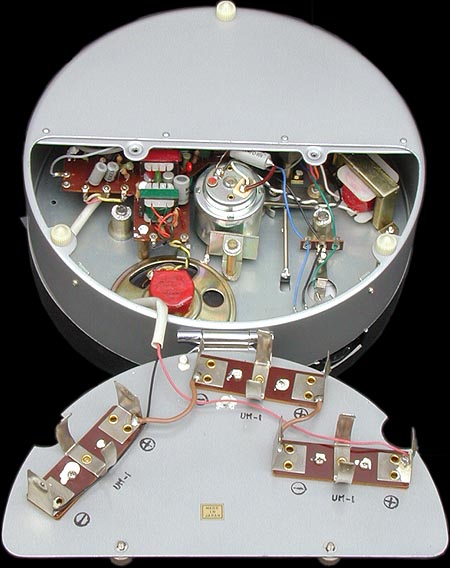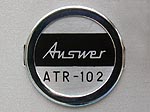 Answer ATR-102 Triplecorder, ca. 1964 Approximately 7-7/8 inches / 20 cm in diameter, excluding projections. This wacky, round tape recorder has a built-in AM broadcast-band radio. Transistor AM radios of this era usually use a ferrite loop antenna, but that won't work here because the unit's case is all metal and would block the signals from reaching the antenna. The problem is solved in this unit with the external telescopic rod antenna. I left the reels in their plastic bags. I just couldn't bear to take them out. At least we know there's no old recording on this tape waiting to reveal itself to me—the tapes have never been unwrapped (and the recorder has never been used). |
 | Above is a closeup of the metal banner that's riveted to the top of the case lid. At left is a closeup showing the radio dial, which peeks through a slot in the lid when it's closed. There are calibration marks on the top and the side of the dial for easy viewing from the top with the lid open, and from the side with the lid closed. The purpose of that metal post to the right of the dial is a mystery. |
| Here's the unit with its box, accessories, and original batteries. You can see what the recorder looks like with its lid closed. That circular grille at the left rear of the lid lets the sound out when the lid is closed—it's directly over the speaker on the main deck. |  |
 | This is the front of the box. |
It's a triplecorder—recorder, radio and phonograph! You attach the accessory turntable to the takeup reel spindle, plug the accessory tonearm into the external input jack and—voilà!—you get a phonograph that plays 45-rpm records. What will they think of next? |  |
 | This is the accessory parts kit, which contains, all neatly ensconced in a zippered vinyl carrying case, the tone arm, chromed metal needle guard, turntable, spindle adapter for the larger center hole most 45-rpm records have, and the Triplecorder instruction manual. |
Some explanantory diagrams excerpted from the instruction manual. |  |
 | But wait, there's more! Here's a view of the underside of the unit, with the battery compartment open, revealing some innards. |

Home | What's New? | Site Map | Links | Help
Wood Radios | Plastic Radios | Transistor Radios
Record Players | Recorders | Ham Radio
Copyright © 1996-2020 John C. Pelham. All rights reserved.